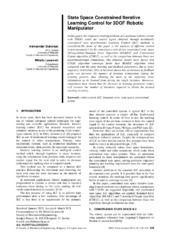Приказ основних података о документу
Iterativno upravljanje učenjem u ograničenom prostoru stanja robotskog manipulatora sa 3 stepena slobode
State space constrained iterative learning control for 3DOF robotic manipulator
| dc.creator | Dubonjac, Aleksandar | |
| dc.creator | Lazarević, Mihailo | |
| dc.date.accessioned | 2022-09-19T19:18:17Z | |
| dc.date.available | 2022-09-19T19:18:17Z | |
| dc.date.issued | 2021 | |
| dc.identifier.issn | 1451-2092 | |
| dc.identifier.uri | https://machinery.mas.bg.ac.rs/handle/123456789/3568 | |
| dc.description.abstract | U ovom radu je razmatrano praćenje trajektorije nelinearnog robotskog sistema sa 3 stepena slobode pod dejstvom upravljanja dobijenog primenom nelinearnih metoda iterativnog upravljanja učenjem (ILC) u ograničenom prostoru stanja. Fokus rada je analiza uticaja različitih parametara upravljačkog sistema na brzinu konvergencije dva ILC algoritma u ograničenom prostoru stanja: Algoritma ograničene greške i algoritma ograničenog izlaza, i međusobno poređenje ovih algoritama kroz simulacije.Dobijeni rezultati su pokazali da COILC algoritam konvergira brže od BEAILC algoritma, kada se uporede sa istim vrednostima parametara učenja i povratne grane, usled slabijih ograničenja trajektorije. Takođe, pokazano je da povećanje vrednosti parametara u povratnoj grani smanjuje broj prekida iteracija tokom procesa učenja, time omogućavajući više informacija za učenje iz greške praćenja trajektorije u iteraciji. Dalje, simulacije su pokazale da smanjenje vrednosti parametara učenja povećava broj iteracija potrebnih da se dostigne željena tačnost praćenja. | sr |
| dc.description.abstract | In this paper, the trajectory tracking problem of a nonlinear robotic system with 3DOFs under the control signal obtained through nonlinearly constrained state spaceIterative Learning Control (ILC) methods is considered. The focus of this paper is the analysis of different control system parameters on the convergence rate of two constrained state space ILCalgorithms: Bounded Error Algorithm (BEAILC) and Constrained Output algorithm (COILC), as well as the comparison between these two algorithms through simulations. The obtained results have shown that COILC algorithm converges faster than BEAILC algorithm when compared with the same learning and feedback parameters, due to lower trajectory restrictions. Also, it has been shown that an increase in feedback gains can decrease the number of iteration terminations during the learning process, thus allowing for more of the trajectory error information to be learned from during the single iteration. Moreover, simulations have shown that the decrease in learning parameter values will increase the number of iterations required to obtain the desired tracking accuracy. | en |
| dc.publisher | Univerzitet u Beogradu - Mašinski fakultet, Beograd | |
| dc.relation | info:eu-repo/grantAgreement/MESTD/inst-2020/200105/RS// | |
| dc.rights | openAccess | |
| dc.rights.uri | https://creativecommons.org/licenses/by/4.0/ | |
| dc.source | FME Transactions | |
| dc.subject | state space | en |
| dc.subject | robot control | en |
| dc.subject | ILC | en |
| dc.subject | constrained output | en |
| dc.subject | bounded error | en |
| dc.title | Iterativno upravljanje učenjem u ograničenom prostoru stanja robotskog manipulatora sa 3 stepena slobode | sr |
| dc.title | State space constrained iterative learning control for 3DOF robotic manipulator | en |
| dc.type | article | |
| dc.rights.license | BY | |
| dc.citation.epage | 436 | |
| dc.citation.issue | 2 | |
| dc.citation.other | 49(2): 429-436 | |
| dc.citation.rank | M24 | |
| dc.citation.spage | 429 | |
| dc.citation.volume | 49 | |
| dc.identifier.doi | 10.5937/fme2102429D | |
| dc.identifier.fulltext | http://machinery.mas.bg.ac.rs/bitstream/id/2150/3565.pdf | |
| dc.identifier.scopus | 2-s2.0-85110053379 | |
| dc.identifier.wos | 000637649000018 | |
| dc.type.version | publishedVersion |


